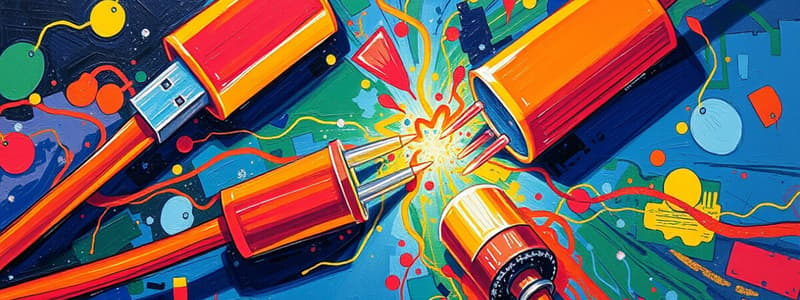Podcast
Questions and Answers
What is the interface called between the body and electronic measuring devices?
What is the interface called between the body and electronic measuring devices?
Electrode-Electrolyte Interface
Which of the following is true about the flow of current at the Electrode-Electrolyte Interface?
Which of the following is true about the flow of current at the Electrode-Electrolyte Interface?
- Cations move in the opposite direction to current flow
- Anions move in the same direction as current flow
- Electrons move in the opposite direction to current flow (correct)
- Electrons flow in the same direction as current
Current is carried in the body by electrons.
Current is carried in the body by electrons.
False (B)
To sense a signal, a current must flow at the ______.
To sense a signal, a current must flow at the ______.
Which reactions occur at the Electrode-Electrolyte Interface?
Which reactions occur at the Electrode-Electrolyte Interface?
What type of electrodes change ionic current into electronic current?
What type of electrodes change ionic current into electronic current?
Flashcards are hidden until you start studying
Study Notes
Bio-potential Electrodes Overview
- Bio-potential electrodes facilitate interaction between the body and electronic measuring devices; they conduct current across this interface.
- Current in biological tissues is carried by ions, while electronic devices operate with electrons.
- Essential function of electrodes is to convert ionic current (in the body) to electronic current (in devices) at the Electrode-Electrolyte Interface.
Current Flow and Electrode-Electrolyte Interface
- Electrons and ions flow in opposite directions at the interface, crucial for signal detection.
- Cations (C+) move in the same direction as the current flow, whereas anions (A–) move opposite to current flow.
- Chemical reactions occur during current flow:
- Oxidation reaction: C ⇌ C+ + e–
- Reduction reaction: A– ⇌ A + e–
- No current occurs at equilibrium states, highlighting the importance of active current for electrode function.
Key Components of Bio-potential Electrodes
- The structure of electrodes includes a metal component in contact with an electrolyte.
- The interaction between the metal (M) and electrolyte (M+) is vital for effective current sensing.
- To effectively sense a signal (I), a current must be allowed to flow across the electrode-electrolyte interface.
Electrode Types
- Body-surface recording electrodes monitor external biopotentials.
- Internal electrodes are used for deeper signal acquisition within the body.
- Electrode arrays allow for multi-point measurements, enhancing signal detection and analysis.
Practical Considerations
- Understanding polarization effects is essential; electrodes can be polarized (changing impedance under current flow) or nonpolarized (stable impedance).
- Motion artifacts can affect signal integrity, emphasizing the need for proper placement and stabilization of electrodes during measurement.
Studying That Suits You
Use AI to generate personalized quizzes and flashcards to suit your learning preferences.




